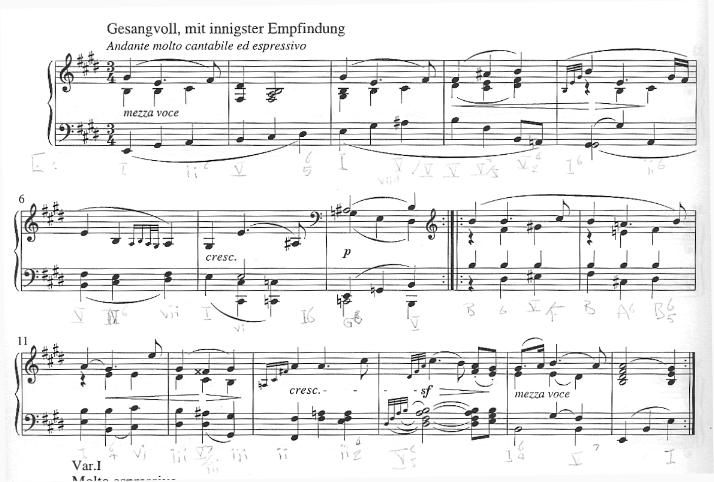10 September 2004
Augmented 6th chords
In which we quickly revisit our old friends--the Italian, French, and German sixth chords--via the second movement of Beethoven's Piano Sonata No. 30, opus 109.

From my scribbled analysis, you can see the Italian sixth in the third beat of measure seven (C-E-A#) and the German sixth in the first two beats of measure eight (C-E-G-A#). This is the deal with the augmented sixths [Wikipedia] (using C major):
- Borrow the lowered sixth degree from the parallel minor (borrow Ab from C minor),
- Add the tonic (C),
- Add raised fourth degree, the leading tone of the dominant key (F# from G major),
- The Italian sixth consists of those three notes,
- The French sixths adds the second scale degree to those three notes (D, the dominant of the dominant key),
- The German sixth adds the lowered third degree from the parallel minor (borrow Eb from C minor)
The augmented of augmented sixth is the interval of the lowered sixth (Ab) and the raised fourth (F#). This is enharmonic [Wikipedia] to a minor seventh, but because of the scale degrees (A B C D E F) it is treated, and heard, as a sixth. Because the augmented sixth borrows notes from the dominant of the dominant, it will generally resolve to the dominant (or the I64). The dominant always wants to resolve to the tonic. In C, the dominant is G and it will resolve to C. In C, the dominant of the dominant (V/V) is D. Teoria has a nice explanation of augmented sixths along with notation and MIDI examples (ack, the examples are in A for some reason).
Chapter 24 of Walter Piston's Harmony covers the augmented sixth chords. I learned the names from a now lost book on music theory from seventh or eighth grade. Piston, as of 1969, says they're not widely accepted and uses these:
- Italian -> augmented sixth,
- French -> augmented six-four-three (V43/V),
- German -> augmented six-five-three (V65/V), enharmonic doubly augmented fourth (Eb written as D#)
With so many altered notes and variations, the augmented sixth chords can be mired in enharmonic analysis and chord names and inversions (I respectfully question some of Piston's choices--he's a god of mine, so it's very quietly and respectfully). However, the list above describing how to build them is consistent (Ab, C, F#, etc.).
The second movement of Beethoven's Piano Sonata No. 30 is a theme with six variations. Beethoven uses augmented sixths at the end of the first phrase of the theme as a half cadence [Wikipedia]. With it, he leaves you on a lovely precipice. Look at the melody, eight measures plus eight measures:
- Measures 1..2 and 3..4 parallel each other: descending thirds G#-E D#-B in the first two, becomes G#-E F#-A# (ascending) in the second. Repetition and variation.
- Measures 5..6 and 7..8 parallel each other in a similar-but-different manner: descending fifth and fourth B-E E-B in the first two, becomes G#-E (ascending) A#-B (ascending) in the second.
- Measures 3..4 tonicize the dominant and end on a half-cadence via the V/V. Measures 7..8 tonicize the dominant and end on a half-cadence via the augmented sixth.
We listen to and enjoy the melody, and looking at the basic analysis we can begin to understand--begin to get a small glipse--of where our enjoyment comes from. This melody is a type of looking-into-the-abyss. A good type of looking into the abyss where we might begin to understand the structure but we have no idea how the composer came up with it. I don't like to bring this comparison up, because it holds too much weight, but this is how I see god. Beethoven, and any artist at their best, found a way to open up a hole to the depths and translate it in some form to us.
OK. Maybe the melody's not that important. But it is really really good.
I'm always ashamed at myself when I see composers do something like in measure six. The melody consists almost entirely of non-harmonic tones. His harmonization (V IV6 vii) is perfect for the phrase, but unexpected for the melody itself. As an amateur, it's easy (too easy) to look at these unexpected choices and consider it genius coming from a genius yet flawed coming from a hack (or those that we consider hack). This is an important point: always be aware of your own limitations.
- Classical Music Archives: Beethoven (MIDI)
- Teoria (music theory)
- The vinyl and the concert posted by sstrader on 21 May 2016 at 1:59:26 PM
- Rod McKuen posted by sstrader on 22 March 2016 at 8:58:35 PM
- More political transcriptions posted by sstrader on 20 March 2016 at 10:19:06 AM
- Notes on We Don't Care About Music Anyway posted by sstrader on 7 June 2015 at 1:06:34 PM
- Ives Concord Sonata posted by sstrader on 13 February 2015 at 5:13:17 PM